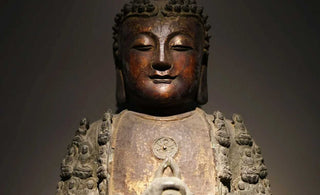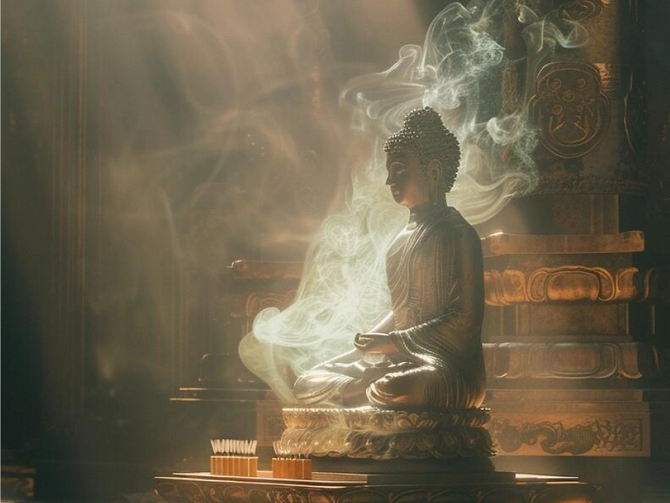
Today we delve into the captivating world of Grey Limestone Buddha statues. In this article, we will explore the origins and profound significance of these remarkable sculptures, showcasing their historical legacy and artistic allure.
The Ancient Artistry of Grey Limestone Buddha Statues
Grey Limestone Buddha statues hold a special place in the realm of oriental art, with their origins dating back to ancient times. Crafted from limestone, these statues offer a unique and captivating aesthetic. The grey hue of the stone, coupled with its smooth texture, creates an aura of tranquility and serenity, perfectly reflecting the essence of the Buddha's teachings.
The craftsmanship and artistic beauty of Grey Limestone Buddha statues are truly remarkable. Skilled artisans devote their time and expertise to meticulously carve and shape the limestone, bringing the Buddha's image to life. The attention to detail, from the serene facial expressions to the flowing robes, is a testament to the mastery of these artisans and adds to the aesthetic allure of these sculptures.
Ancient Origins and Cultural Significance
The ancient origins of Grey Limestone Buddha statues can be traced back to the magnificent kingdoms and empires of Southeast Asia. It was during this time that Buddhism began to take root and flourish, leaving an indelible mark on the region's cultural and artistic landscape. In countries such as Cambodia, Thailand, and Myanmar, the creation of Grey Limestone Buddha statues became an integral part of the artistic expression and religious devotion of the people.
Cambodia, with its awe-inspiring temple complex of Angkor Wat, holds a prominent place in the history of Grey Limestone Buddha statues. The Khmer Empire, which reached its zenith in the 12th century, embraced Buddhism as its primary religion. The magnificent stone carvings found within the temples of Angkor bear witness to the exquisite craftsmanship and devotion of the Khmer artisans. Grey Limestone Buddha statues, with their serene countenances and graceful postures, adorned the sacred spaces and served as objects of veneration.
In Thailand, the ancient city of Sukhothai played a pivotal role in the development of Grey Limestone Buddha statues. The Sukhothai Kingdom, which thrived from the 13th to the 15th century, saw the emergence of a distinct artistic style characterized by the portrayal of the Buddha in a seated position, known as the "Sukhothai style." The Grey Limestone Buddha statues created during this period embodied a sense of elegance and refinement, reflecting the spiritual aspirations of the Thai people.
Myanmar, formerly known as Burma, also boasts a rich heritage of Grey Limestone Buddha statues. The Pagan Kingdom, which flourished between the 9th and 13th centuries, witnessed a remarkable proliferation of Buddhist art and architecture. The ancient temples of Bagan, with their vast collections of Grey Limestone Buddha statues, stand as a testament to the devotion and artistic prowess of the Burmese artisans. These statues, often adorned with intricate details and embellishments, became revered objects of worship and sources of inspiration.
The cultural significance of Grey Limestone Buddha statues cannot be overstated. These statues not only reflect the artistic achievements of ancient civilizations but also embody the spiritual and philosophical ideals of Buddhism. Buddhism, with its emphasis on compassion, wisdom, and the pursuit of enlightenment, resonated deeply with the people of Southeast Asia. Grey Limestone Buddha statues served as tangible representations of these teachings, reminding individuals of the path to inner peace and liberation from suffering. Moreover, Grey Limestone Buddha statues became focal points for religious rituals, ceremonies, and festivals, bringing communities together in acts of devotion and reverence. These statues were often enshrined within temples and monastic complexes, creating sacred spaces where individuals could seek solace, offer prayers, and engage in meditation.
In the present day, the cultural significance of Grey Limestone Buddha statues continues to endure. These statues are cherished not only for their artistic beauty but also for their ability to evoke a sense of tranquility and spiritual connection. They serve as tangible links to the rich cultural heritage of Southeast Asia, carrying forward the traditions and teachings of Buddhism to future generations.
Symbolism and Spiritual Significance
Grey Limestone Buddha statues hold deep symbolism and spiritual significance, representing the core tenets of Buddhism and serving as powerful reminders of the path to enlightenment. These statues, with their serene expressions and contemplative postures, encapsulate the essence of the Buddha's teachings and inspire devotees and art enthusiasts alike.
The Buddha, also known as Siddhartha Gautama, was a spiritual teacher who lived in ancient India and founded the religion of Buddhism. His teachings revolved around the Four Noble Truths and the Eightfold Path, offering guidance on how to attain liberation from suffering and achieve enlightenment. Grey Limestone Buddha statues serve as visual representations of the Buddha's enlightened state and embody the qualities that he epitomized. The serene facial expressions, closed eyes, and gentle smiles of these statues convey a sense of inner peace, compassion, and wisdom. They serve as powerful symbols of the enlightened mind, inspiring individuals to cultivate these qualities within themselves.
The seated posture of the Buddha, known as the lotus position or the "meditation pose," is a common depiction in Grey Limestone Buddha statues. This posture symbolizes stability, grounding, and inner reflection. It represents the state of deep meditation and the ability to remain calm and centered amidst the challenges of life. The crossed legs and the hands placed in specific mudras (hand gestures) hold deeper meanings, each conveying a unique aspect of the Buddha's teachings.
For example, the Dhyana Mudra, where the hands are placed in the lap with the right hand resting on top of the left, palms upward, represents meditation and concentration. It symbolizes the state of deep contemplation and the pursuit of inner stillness. The Abhaya Mudra, where the right hand is raised with the palm facing outward, signifies fearlessness, protection, and the dispelling of negativity. The spiritual significance of Grey Limestone Buddha statues extends beyond their symbolic representations. These statues are believed to radiate positive energy and inspire a sense of peace and harmony in their presence. Many individuals and communities create sacred spaces dedicated to the worship and contemplation of these statues, where they can engage in meditation, offer prayers, and seek spiritual solace.
Moreover, Grey Limestone Buddha statues serve as reminders of the ethical and moral principles advocated by Buddhism. The Buddha's teachings emphasize compassion, loving-kindness, and the importance of leading a virtuous life. By having a Grey Limestone Buddha statue in one's home or sacred space, individuals are constantly reminded of these principles and inspired to cultivate them in their daily lives. The spiritual significance of Grey Limestone Buddha statues transcends cultural and geographical boundaries. They are revered by Buddhists and non-Buddhists alike, who are drawn to their profound symbolism and the universal values they represent. These statues serve as conduits for personal reflection, inspiring individuals to embark on their own spiritual journeys and seek inner transformation.
For collectors, artists, and enthusiasts who appreciate classical oriental art, Grey Limestone Buddha statues hold immense value. These sculptures not only serve as exquisite additions to art collections but also provide a profound connection to the historical and cultural heritage of Southeast Asia. Owning a Grey Limestone Buddha statue allows individuals to appreciate the timeless beauty and spiritual significance of these ancient works of art.Each statue in our collection is chosen with care, ensuring that it embodies the spiritual essence and artistic mastery that have made Grey Limestone Buddha statues timeless symbols of enlightenment and inner peace.
























